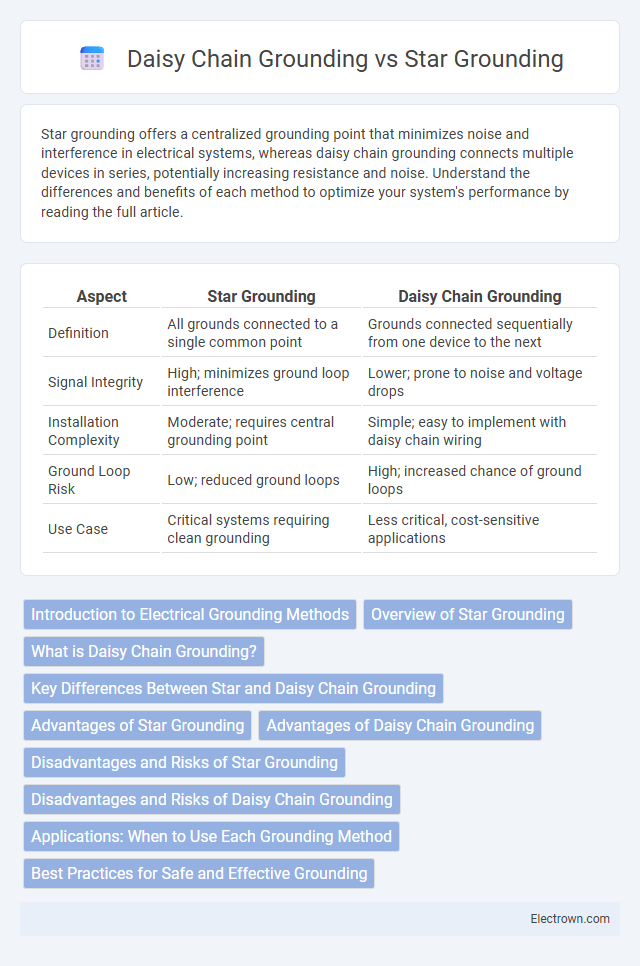Star grounding offers a centralized grounding point that minimizes noise and interference in electrical systems, whereas daisy chain grounding connects multiple devices in series, potentially increasing resistance and noise. Understand the differences and benefits of each method to optimize your system's performance by reading the full article.
Table of Comparison
| Aspect | Star Grounding | Daisy Chain Grounding |
|---|---|---|
| Definition | All grounds connected to a single common point | Grounds connected sequentially from one device to the next |
| Signal Integrity | High; minimizes ground loop interference | Lower; prone to noise and voltage drops |
| Installation Complexity | Moderate; requires central grounding point | Simple; easy to implement with daisy chain wiring |
| Ground Loop Risk | Low; reduced ground loops | High; increased chance of ground loops |
| Use Case | Critical systems requiring clean grounding | Less critical, cost-sensitive applications |
Introduction to Electrical Grounding Methods
Star grounding ensures a single, central ground point where all electrical circuits connect, minimizing ground loops and reducing electromagnetic interference. Daisy chain grounding links multiple devices in series to a common ground path, which can introduce noise and voltage differences affecting signal integrity. Your choice between star and daisy chain grounding methods directly impacts the stability and performance of electrical systems.
Overview of Star Grounding
Star grounding involves connecting all ground points directly to a single central node, minimizing ground loops and interference in electronic circuits. This method ensures low impedance paths and reduces noise by preventing current flow through unintended ground connections. It is widely used in sensitive audio and RF systems to maintain signal integrity and improve overall performance.
What is Daisy Chain Grounding?
Daisy Chain Grounding refers to a wiring method where multiple components share a single connection path by linking grounds sequentially in series, resembling a chain. This setup can lead to increased ground resistance and potential interference due to shared ground paths, impacting signal integrity and electrical performance. Understanding this method helps you make informed decisions about grounding strategies in electrical and electronic systems.
Key Differences Between Star and Daisy Chain Grounding
Star grounding provides a single, central grounding point where all ground connections converge, minimizing ground loops and reducing electrical noise in your system. Daisy chain grounding connects multiple grounds sequentially, which can increase the risk of interference and voltage drops along the chain. Choosing star grounding improves signal integrity and system reliability compared to the simpler but less effective daisy chain approach.
Advantages of Star Grounding
Star grounding offers superior noise reduction by minimizing ground loops, improving signal integrity in sensitive electronic circuits. Concentrating all ground connections at a single point enhances fault detection and simplifies troubleshooting, increasing overall system reliability. This method also provides consistent reference voltage levels, crucial for high-precision measurement and communication systems.
Advantages of Daisy Chain Grounding
Daisy chain grounding offers simplified wiring and reduced installation costs by connecting multiple components in a linear sequence with a single grounding conductor. This method minimizes material usage and space requirements, making it suitable for compact or cost-sensitive electrical systems. You benefit from easier troubleshooting in systems with fewer grounding points compared to complex star grounding configurations.
Disadvantages and Risks of Star Grounding
Star grounding presents risks such as increased complexity in large systems, which can lead to difficulty in managing and troubleshooting ground connections. Improper implementation may cause ground loops or voltage differences due to long star point wiring, resulting in noise and interference in sensitive electronic circuits. The single star point becomes a critical failure point; any fault there can compromise the entire grounding system's effectiveness.
Disadvantages and Risks of Daisy Chain Grounding
Daisy chain grounding poses significant risks such as increased ground impedance, which can lead to voltage differences and potential ground loops, causing equipment malfunction and noise interference. Its sequential connection structure makes troubleshooting challenging and can result in a single point of failure disrupting the entire grounding system. This method also lacks the reliability of star grounding, where each device has an independent path to a common ground, minimizing noise and enhancing system safety.
Applications: When to Use Each Grounding Method
Star grounding is ideal for sensitive electronic systems such as audio equipment and precision measurement devices where minimizing ground loops and noise is critical. Daisy chain grounding suits applications involving multiple interconnected devices like industrial control panels or communication racks where simplicity and ease of installation are prioritized. Selecting the proper grounding method depends on the complexity of the system, noise sensitivity, and physical layout constraints.
Best Practices for Safe and Effective Grounding
Star grounding ensures each device connects directly to a single grounding point, minimizing ground loops and electrical noise, which is essential for safe and effective grounding in sensitive electronic systems. Daisy chain grounding links multiple devices sequentially, increasing the risk of voltage potential differences and interference, compromising system reliability. Your system's safety and performance improve by adhering to star grounding best practices in complex or high-precision environments.
Star grounding vs daisy chain grounding Infographic

 electrown.com
electrown.com